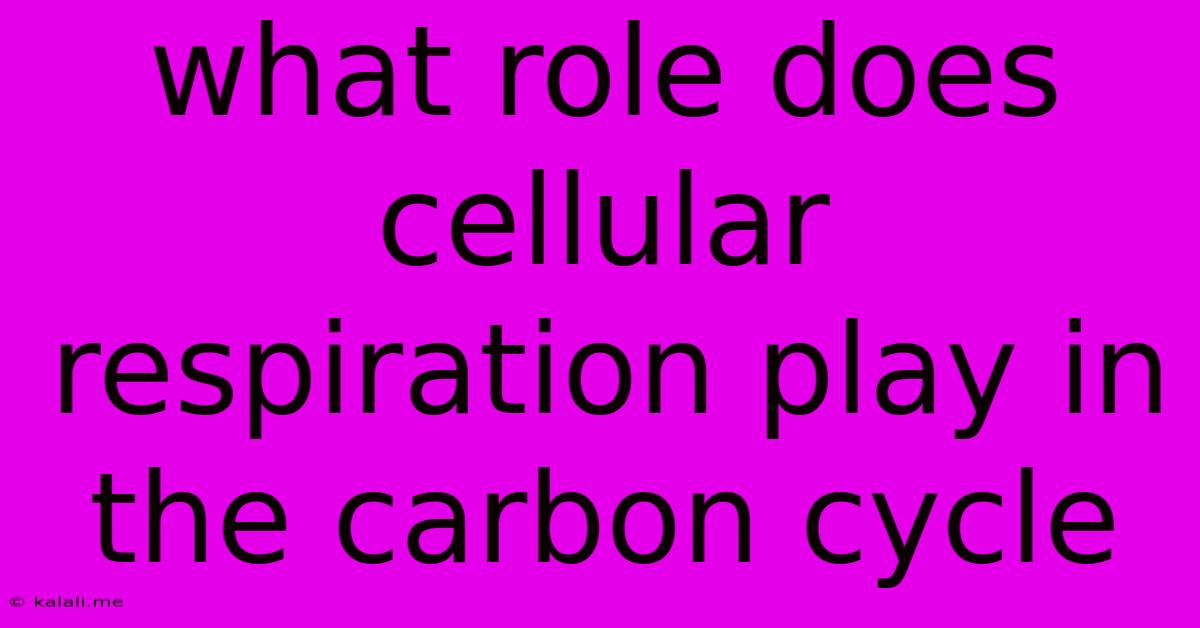What Role Does Cellular Respiration Play In The Carbon Cycle
Kalali
May 09, 2025 · 3 min read

Table of Contents
Cellular Respiration's Crucial Role in the Carbon Cycle
Cellular respiration is a fundamental process in all living organisms, playing a vital role in the global carbon cycle. This article delves into the intricate relationship between cellular respiration and the cycling of carbon through various ecosystems, exploring its impact on atmospheric carbon dioxide levels and the overall health of the planet. Understanding this interplay is critical to comprehending climate change and developing strategies for carbon mitigation.
Cellular respiration is the process by which organisms break down organic molecules, primarily glucose, to release energy in the form of ATP. This energy fuels various cellular processes essential for life. Crucially, this process involves the oxidation of carbon atoms, releasing carbon dioxide (CO2) as a byproduct. This CO2 is then released into the atmosphere or, in aquatic organisms, into the surrounding water.
The Interplay Between Respiration and Carbon Dioxide Levels
The significance of cellular respiration in the carbon cycle lies in its direct contribution to atmospheric CO2. Plants, through photosynthesis, absorb CO2 from the atmosphere and convert it into organic molecules. Animals and other heterotrophs then obtain carbon by consuming these plants or other organisms. Cellular respiration in these organisms reverses this process, breaking down the organic molecules and releasing CO2 back into the atmosphere or water. This constant exchange of carbon between the atmosphere and living organisms is a crucial component of the global carbon cycle.
Respiration in Different Ecosystems
The role of cellular respiration varies across different ecosystems. In forests, for example, a significant amount of carbon is stored in the biomass of trees. Cellular respiration by trees and other organisms releases CO2, affecting the net carbon sequestration capacity of the forest. Similarly, in aquatic ecosystems, respiration by marine organisms plays a key role in the carbon cycle in the oceans. This includes respiration by phytoplankton, zooplankton, and other marine life, impacting the ocean's capacity to absorb CO2 from the atmosphere.
Impact on Climate Change
The balance between photosynthesis and cellular respiration significantly influences atmospheric CO2 levels. Human activities, such as deforestation and the burning of fossil fuels, have disrupted this balance, leading to a significant increase in atmospheric CO2 and contributing to climate change. Increased CO2 levels enhance the greenhouse effect, trapping heat and causing global warming. Understanding the role of cellular respiration in this process is crucial for developing strategies to mitigate climate change.
Other Aspects of Carbon Cycling Through Respiration
It is important to note that cellular respiration isn't solely responsible for carbon dioxide release. Decomposition of organic matter also plays a vital role. When organisms die, decomposers break down their organic matter, releasing CO2 into the atmosphere through their own respiration processes. This process is particularly significant in soil ecosystems, where microbial respiration contributes significantly to CO2 emissions. The efficiency of this decomposition process, influenced by factors like temperature and moisture, will affect the overall rate of CO2 release back into the atmosphere.
Conclusion: A Fundamental Process With Global Implications
In conclusion, cellular respiration is a fundamental process inextricably linked to the global carbon cycle. Its contribution to atmospheric CO2 levels is significant, and understanding this relationship is crucial for addressing climate change. While photosynthesis acts as a carbon sink, cellular respiration acts as a carbon source. The dynamic balance between these two processes, along with other factors like decomposition, ultimately determines the net amount of CO2 in the atmosphere and its impact on our planet's climate. Further research into the intricacies of cellular respiration across diverse ecosystems is vital for developing effective strategies to manage and mitigate the effects of climate change.
Latest Posts
Latest Posts
-
98 Cm To Inches And Feet
May 09, 2025
-
What Is The Fraction Of 0 01
May 09, 2025
-
51 Inches To Feet And Inches
May 09, 2025
-
What Is 59 Degrees Celsius In Fahrenheit
May 09, 2025
-
40 Is What Percent Of 70
May 09, 2025
Related Post
Thank you for visiting our website which covers about What Role Does Cellular Respiration Play In The Carbon Cycle . We hope the information provided has been useful to you. Feel free to contact us if you have any questions or need further assistance. See you next time and don't miss to bookmark.